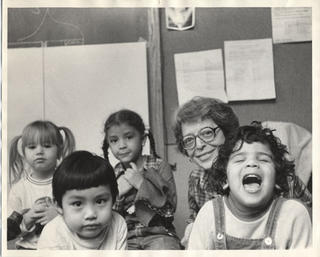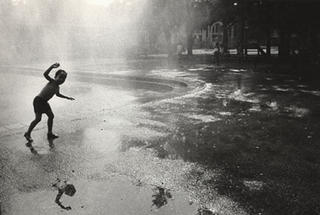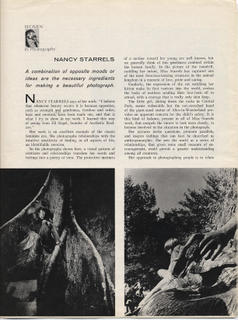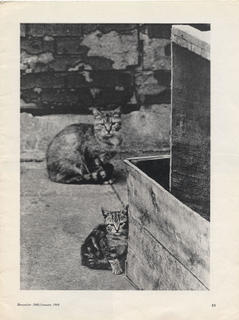Nancy Starrels (1921-1984) was born in Chicago. She graduated from the State University of Iowa, where her studies in philosophy and poetry began. In 1943 she came to New York and began her study of Aesthetic Realism with its founder, the poet and philosopher Eli Siegel. Her poetry appears in the book Personal & Impersonal: Six Aesthetic Realists (Terrain Gallery, 1959).), Poems by Sheldon Kranz, Louis Dienes, Nancy Starrels, Nat Herz, Martha Baird, Rebecca Fein; with a Critical Preface by Eli Siegel.
In 1966 she began taking photographs and later became a teacher of photography: first at the Hamilton Madison Settlement House on Catherine Street where she broke new ground by teaching aesthetics to children and teenagers. She was one of the Aesthetic Realism Photographers, an organization of professional photographers, educators and critics, which included Lou Bernstein whose work was in The Family of Man and Ralph Hattersley, editor of Infinity magazine. In 1976, she and David Bernstein, in honor of International Working Woman’s Year, organized their two-person exhibition illustrating Eli Siegel’s essay “A Woman Is a Oneness of Aesthetic Opposites,” which traveled throughout the tri-state area. . In 1980 she curated an exhibition of work by 50 photographers celebrating the 25th anniversary of the Terrain Gallery and Eli Siegel’s Is Beauty the Making One of Opposites?
Nancy Starrels was Chairman of the Photography Department at Pratt-Phoenix School of Design from 1971-1976 and was Director of Photography at Henry Street Settlement from 1976-1981. She developed some of the most innovative and successful programs in the teaching of photography, including for Head Start children, parents and children together, and for young people with learning difficulties. Another pioneering class brought together seniors and Head Start children.Some of her students went on to win scholarships to Rochester Institute of Technology and their photographs appear in the Time-Life Photography Series. One of her students, James Cuebas, taught photography at Henry Street Settlement.
The people and buildings of the Lower East Side were important in her photography. For instance, when she heard that one of the oldest synagogues (on Attorney Street) was to be renovated, she went there and preserved in photographs the remaining original structure.
In 1981 she became a consultant to women on the faculty of the not-for-profit Aesthetic Realism Foundation. There she also taught two photography classes, one in darkroom techniques and “The Honoring Eye” (1977-1984) which had a big impact on the work of professional photographers and others. The basis of her photography and teaching was Eli Siegel's statement: "All beauty is a making one of opposites, and the making one of opposites is what we are going after in ourselves."
In her Portfolio in Camera 35, she wrote: “I believe that whenever beauty occurs it is because opposites, such as strength and gentleness, freedom and order, logic and emotion, have been made one, and that is what I try to show in my work.”
In public seminars and presentations at the Aesthetic Realism Foundation, she talked about the lives and work of women and men in literature and the arts, for example, "The Greatness of Alfred Stieglitz," "The Gaiety of Jacques Henri Lartigue," and on Colette, Elizabeth Barrett Browning, Dorothea Lange, Margaret Bourke-White, Diane Arbus, Georgia O'Keefe, and others.
She was an author and co-author of articles for Infinity, Camera 35, Popular Photography and other journals, and her story "Head Start Photographers" was published in New York State Art Teachers Association Bulletin. Portfolios of her work appeared in Camera 35 and Popular Photography.
In 1976 Nancy Starrels had a solo exhibition at the Hudson Park Library; and in 1985, the Terrain Gallery mounted a major retrospective of her work.
This blog is being created by friends and colleagues of the late Nancy Starrels (1921-84), who was a poet, photographer, and Aesthetic Realism Consultant.
Sunday, October 09, 2005
Tuesday, September 20, 2005
Aesthetic Realism and the Answer to Racism
Orange Angle Press has published a book, Aesthetic Realism and the Answer to Racism--Articles Published Nationwide and Abroad by Alice Bernstein and Others. Among the authors are persons who were colleagues of Nancy Starrels and persons who studied with her in The Honoring Eye class held at the Aesthetic Realism Foundation. To find out about this book and speaking engagements on this urgent subject in colleges, libraries and other educational venues, visit the website of the publisher: http://www.orangeanglepress.com
Saturday, July 16, 2005
James Cuebas Remembers Nancy Starrels at Henry Street Settlement
Here is a message from photographer James Cuebas who studied with, and later assisted Nancy Starrels when she was Director of Photography programs at the Henry Street Settlement in New York City:
Hello Alice
Attached is a photograph of Nancy with a group of Headstart Children. I dont know who took this photograph, however my guess is that Nancy had one of the Children in the group take this picture.

Nancy created and taught Photography classes for people of all ages--from 4 to 94. I could say I feel like a Millioinaire. Enriched for the rest of my life from my teacher Nancy Starrels. This is all i will say for now. I will continue to e-mail more of my memories of Nancy.

Also attached you will see Nancy's work in Camera Arts Magazine (below) and one of my photographs that she liked very much (above) and which i mailed to her as a Get well card before she passed away in 1984.
Respectfully,
James Cuebas



Hello Alice
Attached is a photograph of Nancy with a group of Headstart Children. I dont know who took this photograph, however my guess is that Nancy had one of the Children in the group take this picture.

Nancy created and taught Photography classes for people of all ages--from 4 to 94. I could say I feel like a Millioinaire. Enriched for the rest of my life from my teacher Nancy Starrels. This is all i will say for now. I will continue to e-mail more of my memories of Nancy.

Also attached you will see Nancy's work in Camera Arts Magazine (below) and one of my photographs that she liked very much (above) and which i mailed to her as a Get well card before she passed away in 1984.
Respectfully,
James Cuebas



Wednesday, April 13, 2005
50th Anniversary Exhibition at the Terrain Gallery
On Saturday, May 7, 2005, a major event will take place in the art world at the opening of the 50th anniversary exhibition of the Terrain Gallery, located at 141 Greene Street in Manhattan's SoHo district. In 1955 the Terrain opened with artist Dorothy Koppelman as founding director. A statement by Dorothy Koppelman appears on the announcement of the anniversary show. The opening is from 2-5pm. The work of some of the foremost contemporary American artists will be on viewincluding Edmond Casarella, Richard Anuszkiewicz, Rolph Scarlett, Arnold Schmidt, Richard Claude Ziemann. Nancy Starrels is among the photographers in what promises to be a thrilling exhibition. Read the historic announcement and come to see and celebate! http://www.terraingallery.org/
Sunday, March 20, 2005
The Opposites in Photography
Nancy Starrels was a photographer and a teacher of photography. To find out about her class, The Honoring Eye, which she taught for many years at the not-for-profit Aesthetic Realism Foundation, you can follow this link to an article by photographer Len Bernstein, http://www.lenbernstein.com/SCDemocrat.html
In coming months we will be posting more about her teaching, including as the Photography Director at the Henry Street Settlement in New York City for eight years.
In coming months we will be posting more about her teaching, including as the Photography Director at the Henry Street Settlement in New York City for eight years.
Saturday, March 05, 2005
Surface and Depth: Works on Paper
Surface & Depth: Works on Paper, the current exhibition at the Terrain Gallery, 141 Greene Street in Manhattan's SoHo district includes photographs by Nancy Starrels and others.
Prints, drawings, and photographs by over twenty artists, including JIM DINE, ROY LICHTENSTEIN, HAROLD KRISEL, ALLAN D’ARCANGELO, CHAIM KOPPELMAN, ALEX KATZ, DOROTHY KOPPELMAN, LUISA BERTANI, DAVID BERNSTEIN, MICHAEL KNIGIN, EDMOND CASARELLA, NANCY STARRELS, LEN BERNSTEIN, JIM ZVER, AL HANSON, MARCIA RACKOW, PETER PHILLIPS, LOUIS DIENES, HAROLD ALTMAN
Here is the link: http://www.terraingallery.org/Exhibitions.html
Prints, drawings, and photographs by over twenty artists, including JIM DINE, ROY LICHTENSTEIN, HAROLD KRISEL, ALLAN D’ARCANGELO, CHAIM KOPPELMAN, ALEX KATZ, DOROTHY KOPPELMAN, LUISA BERTANI, DAVID BERNSTEIN, MICHAEL KNIGIN, EDMOND CASARELLA, NANCY STARRELS, LEN BERNSTEIN, JIM ZVER, AL HANSON, MARCIA RACKOW, PETER PHILLIPS, LOUIS DIENES, HAROLD ALTMAN
Here is the link: http://www.terraingallery.org/Exhibitions.html
Tuesday, February 08, 2005
"The Search"--A Poem by Nancy Starrels
This poem appears in both Personal & Impersonal: Six Aesthetic Realists (Definition Press, NY) and in issue 344 of the international periodical, The Right of Aesthetic Realism to Be Known.
"The Search" by Nancy Starrels
Peek into cupboards, under saucers,
Watch the crevices of stairs.
Look under rugs, under beds, under chairs.
Thrust your arm hard into sofa's insides.
Feel the brittle straw with care.
Be wary of armchairs and cozy pillows,
Be strong and happy naming fears:
Somewhere it is: want to find it!
"The Search" by Nancy Starrels
Peek into cupboards, under saucers,
Watch the crevices of stairs.
Look under rugs, under beds, under chairs.
Thrust your arm hard into sofa's insides.
Feel the brittle straw with care.
Be wary of armchairs and cozy pillows,
Be strong and happy naming fears:
Somewhere it is: want to find it!
Monday, January 24, 2005
Past & Present in Nancy Starrels' Photo "Garden Cafeteria" - A Talk by Chaim Koppelman
We reprint a talk given by esteemed printmaker and Aesthetic Realism consultant Chaim Koppelman, in the Terrain Gallery's historic series of talks titled "Art Answers the Questions of Your Life!"

The more I look at this photograph the more I am affected by what Nancy Starrels shows about the relation of art and everyday life, the past and present. Nancy Starrels and I studied in classes with Eli Sieqel, the great art critic and founder of Aesthetic Realism. It was from him we learned how to look at the past in such a way that we could be proud.
In the "Outline of Aesthetic Realism," Mr. Sieqel says, "The Past Can Be Seen Better," and he writes:
"If we see what has happened to us better, we give the past a more promising future. There is no limit to how well we can see anything in the past. This means the past can join the present and future wisely.”This is the Garden Cafeteria, a famous Lower East Side landmark for many years. What is so striking in this interior is the dramatic juxtaposition of painted scene on the wall representing the past, with the people sitting right at this moment at the tables below and in the foreground.
People do not feel they can make sense of the past; they either try to forget the past, feeling "it was so bad," or glorify it, because "it was so good," and use it to feel the present is dull. Freshly, surprisingly, Nancy Starrels' photo of the Garden Cafeteria shows the two are really together-- naturally, pleasingly, usefully.
The photograph is divided into two horizontal sections, the lower section of actual people, well dressed, at tables, sitting in pairs, alone, in groups, eating, talking, musing. And behind and above them, as background, a large painting showing the East Side streets, buildings and people of the past, covers most of the wall. The juxtaposition of past and present, painted world and living humanity before us, outside view and immediate interior; is very striking. These two views of reality contrast and merge, enrich one another.
Though the diners seem unaware of the painted past behind them, it impinges on their lives, and dramatically, through form, with them. Look how the forms of the three people in the center, continued upward, form an arch with the old country people in the painting. That same arch form is repeated in the building behind them, in the windows of the buildings in the background, and there are related curves in the chairs of the restaurant.
We are led into depth and into the painted scene by the gaze of the person on the lower left side of the photograph, and our eyes move from near to far, from depth to width, from high into the sky to the scene below. There are other important details: the man in the white shirt, whose head casts a shadow on the painting, separating and joining the present and the past, and the painted lamp post which, as it rises, seems to move right out of the painting into the room with the people. What appeared to be two worlds is one picture!
I see more, through this photograph, of the meaning of Eli Siegel's magnificent Aesthetic Realism statement, "The resolution of conflict in self is like the making one of opposites in art."
Friday, January 14, 2005
"The Face of the Past Is Friendly" - A Poem
We begin, those of us who cared deeply for Nancy Starrels--students, colleagues, and friends-- by publishing, with the permission of Definition Press, one of her poems from the book Personal & Impersonal: Six Aesthetic Realists--
And here's a link to the not-for-profit Aesthetic Realism Foundation at 141 Greene Street, New York, NY 10012, where Nancy Starrels taught her historic class in photography, The Honoring Eye. The Aesthetic Realism Foundation has an exciting (and groundbreaking) curriculum in poetry, the visual arts, music, education, anthropology, and marriage, plus Special Dramatic & Musical Events, and every week public seminars (Thursday at 6:30 pm) and dramatic presentations (Saturday 8 pm).
The Face of the Past Is Friendly
by Nancy Starrels
Your life can begin
From this day forward
To welcome what you are
With more of you
Than walked beside me
In a past whose face you fear.
It may help you to know
I have met the past;
Its eyes are clear and blue.
I have held its hand in mine
And together we have climbed
Long flights of stairs
Where once you shivered
And I clutched at shaky banisters,
Afraid of nervous shadows.
I have been with the past long afternoons,
Sitting comfortably on porches.
We have talked intimately, gone forth
In all sorts of weather, quite unharmed.
No words of love have been spoken,
No decisions have been made,
But the face of the past is friendly,
Its eyes are kind and clear.
And here's a link to the not-for-profit Aesthetic Realism Foundation at 141 Greene Street, New York, NY 10012, where Nancy Starrels taught her historic class in photography, The Honoring Eye. The Aesthetic Realism Foundation has an exciting (and groundbreaking) curriculum in poetry, the visual arts, music, education, anthropology, and marriage, plus Special Dramatic & Musical Events, and every week public seminars (Thursday at 6:30 pm) and dramatic presentations (Saturday 8 pm).
Subscribe to:
Posts (Atom)